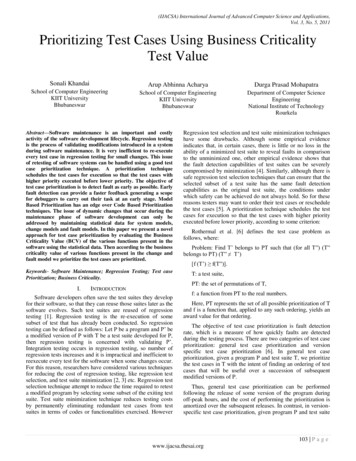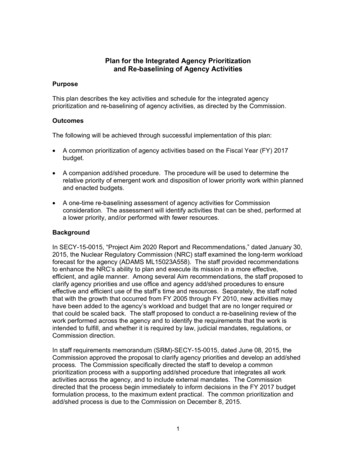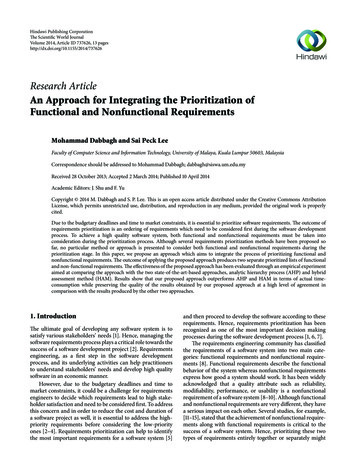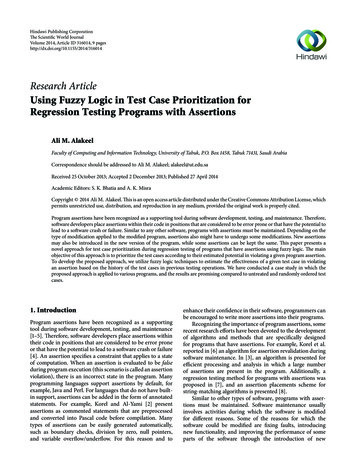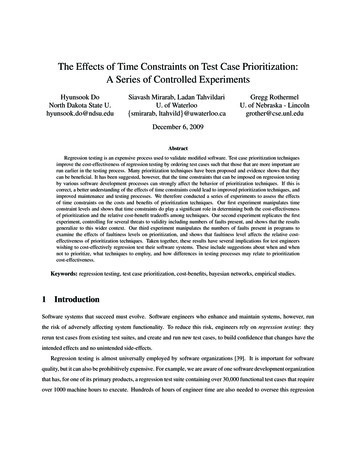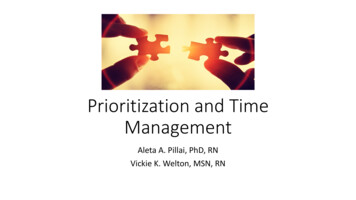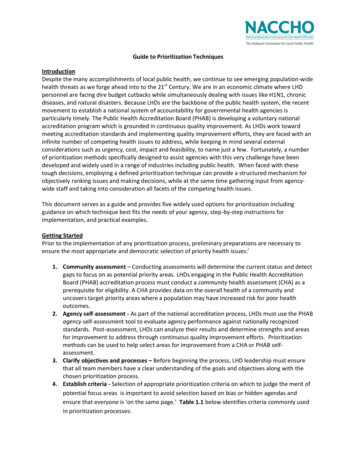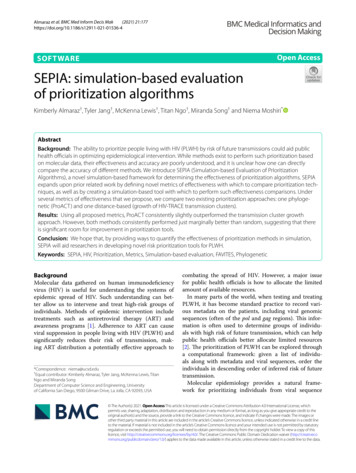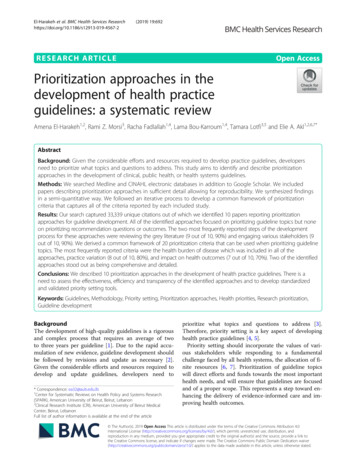
Transcription
El-Harakeh et al. BMC Health Services 2019) 19:692RESEARCH ARTICLEOpen AccessPrioritization approaches in thedevelopment of health practiceguidelines: a systematic reviewAmena El-Harakeh1,2, Rami Z. Morsi3, Racha Fadlallah1,4, Lama Bou-Karroum1,4, Tamara Lotfi3,5 and Elie A. Akl1,2,6,7*AbstractBackground: Given the considerable efforts and resources required to develop practice guidelines, developersneed to prioritize what topics and questions to address. This study aims to identify and describe prioritizationapproaches in the development of clinical, public health, or health systems guidelines.Methods: We searched Medline and CINAHL electronic databases in addition to Google Scholar. We includedpapers describing prioritization approaches in sufficient detail allowing for reproducibility. We synthesized findingsin a semi-quantitative way. We followed an iterative process to develop a common framework of prioritizationcriteria that captures all of the criteria reported by each included study.Results: Our search captured 33,339 unique citations out of which we identified 10 papers reporting prioritizationapproaches for guideline development. All of the identified approaches focused on prioritizing guideline topics but noneon prioritizing recommendation questions or outcomes. The two most frequently reported steps of the developmentprocess for these approaches were reviewing the grey literature (9 out of 10, 90%) and engaging various stakeholders (9out of 10, 90%). We derived a common framework of 20 prioritization criteria that can be used when prioritizing guidelinetopics. The most frequently reported criteria were the health burden of disease which was included in all of theapproaches, practice variation (8 out of 10, 80%), and impact on health outcomes (7 out of 10, 70%). Two of the identifiedapproaches stood out as being comprehensive and detailed.Conclusions: We described 10 prioritization approaches in the development of health practice guidelines. There is aneed to assess the effectiveness, efficiency and transparency of the identified approaches and to develop standardizedand validated priority setting tools.Keywords: Guidelines, Methodology, Priority setting, Prioritization approaches, Health priorities, Research prioritization,Guideline developmentBackgroundThe development of high-quality guidelines is a rigorousand complex process that requires an average of twoto three years per guideline [1]. Due to the rapid accumulation of new evidence, guideline development shouldbe followed by revisions and update as necessary [2].Given the considerable efforts and resources required todevelop and update guidelines, developers need to* Correspondence: ea32@aub.edu.lb1Center for Systematic Reviews on Health Policy and Systems Research(SPARK), American University of Beirut, Beirut, Lebanon2Clinical Research Institute (CRI), American University of Beirut MedicalCenter, Beirut, LebanonFull list of author information is available at the end of the articleprioritize what topics and questions to address [3].Therefore, priority setting is a key aspect of developinghealth practice guidelines [4, 5].Priority setting should incorporate the values of various stakeholders while responding to a fundamentalchallenge faced by all health systems, the allocation of finite resources [6, 7]. Prioritization of guideline topicswill direct efforts and funds towards the most importanthealth needs, and will ensure that guidelines are focusedand of a proper scope. This represents a step toward enhancing the delivery of evidence-informed care and improving health outcomes. The Author(s). 2019 Open Access This article is distributed under the terms of the Creative Commons Attribution 4.0International License (http://creativecommons.org/licenses/by/4.0/), which permits unrestricted use, distribution, andreproduction in any medium, provided you give appropriate credit to the original author(s) and the source, provide a link tothe Creative Commons license, and indicate if changes were made. The Creative Commons Public Domain Dedication o/1.0/) applies to the data made available in this article, unless otherwise stated.
El-Harakeh et al. BMC Health Services Research(2019) 19:692In addition to prioritizing topics, the guideline development process entails the prioritization of questions and outcomes [5, 8]. Similarly, the adaptation of guidelines mayrequire prioritizing which questions addressed in the original guidelines will be adapted [9]. Also, updating guidelines requires prioritization of which guidelines, guidelinesections, or recommendations need to be updated [10].Some investigators have provided general guidanceon the prioritization of topics in guideline developmentby highlighting essential criteria or describing guidingprinciples [11]. Others have developed detailed toolsand approaches for prioritizing topics in guideline development. For example, Schünemann et al. recommended nine steps for priority setting as part of theirguideline development checklist [8].While recognizing the need to outline the variousprioritization approaches and highlight common themes,the aim of this study was to identify and describeprioritization approaches in the development of clinical,public health, or health systems guidelines.MethodsOur study design consisted of a systematic review of thehealth literature to identify prioritization approaches in thedevelopment of health practice guidelines. We followed a detailed methodology that we describe in the protocol includedin Additional file 1. The project’s team included expertise inthe fields of guideline development and priority setting.Eligibility criteria Paper type: We included papers of all types except foreditorials, commentaries, correspondences, letters toeditors, news, and abstracts. We excluded reviews butassessed all of the addressed approaches for potentialeligibility. Scope: We included papers describing a prioritizationapproach in the de novo development, update oradaptation of health practice guidelines addressingclinical, public health, or health systems topics. Thedescription of the approach should be thoroughenough to allow for reproducibility (at least onesection dedicated to that description). We excludedpapers describing prioritization exercises conductedduring guideline development without providing adetailed description of the process used to developthe prioritization approach. We also excluded papersdescribing individual prioritization items or criteria.In addition, we excluded papers where the focus ofthe prioritization approach was different from theguideline development process (e.g., prioritization ofquality indicators derived from clinical guidelines). Setting: We included eligible papers irrespective ofwhether the setting was low-, middle- or high-incomePage 2 of 10countries, or primary, secondary or tertiary healthcarefacilities.Search strategyWe searched Medline and CINAHL electronic databases from their respective dates of inception untilJuly 2019. We developed the search strategy with thehelp of an information specialist. The search combined various terms for health prioritization and included both medical subject headings (MeSH terms)and free-text words. We did not restrict the search tospecific languages or dates. The detailed search strategy is provided in Additional file 2. We complemented the electronic databases search with the manualsearch of Google Scholar. We also screened the reference lists of included and other relevant papers andreviews to retrieve additional studies.Study selectionTeams of two reviewers screened in duplicate and independently all titles and abstracts of identified citationsfor potential eligibility. We retrieved the full texts for citations judged as potentially eligible by at least one ofthe two reviewers. Then, teams of two reviewersscreened the full texts in duplicate and independentlyfor potential eligibility. They resolved disagreements bydiscussion or with the help of a third reviewer (EAA)when consensus could not be reached. We used a standardized and pilot-tested screening form. We also conducted two rounds of calibration exercises before thescreening process.Data abstractionTwo reviewers (AEH and RZM) abstracted data fromeligible studies in duplicate and independently. Theyused a standardized and pilot-tested data abstractionform. Disagreements were resolved by discussion or withthe help of a third reviewer (EAA). We conducted a calibration exercise to enhance the validity of the process.We collected the following data from each includedpaper: General characteristics of the approaches forprioritizing guideline topics: authors; location; year ofpublication; lead entity; target audience; field (e.g.,clinical, public health, or health systems); focus ofprioritization (e.g., guideline topic, recommendationquestions, or outcomes); and type of guidelinedevelopment (update, adaptation or de novodevelopment); Steps of the development process for the approach;we used the abstracted data to come up with acommon categorization of the steps (e.g., literaturereview, consensus building, ranking of proposed
El-Harakeh et al. BMC Health Services Research(2019) 19:692prioritization criteria, pilot testing, primary researchand stakeholder involvement); Aspects proposed to be addressed when prioritizingguideline topics; we used the abstracted data to comeup with a common categorization of the aspects (e.g.,guideline development steps at which prioritizationshould happen, steps for generating an initial list oftopics, prioritization criteria, types of stakeholders toinvolve and method for involvement).Data synthesisDue to the nature of data, we synthesized the findings ina semi-quantitative way. We used the abstracted data tocome up with common categorizations of relevant concepts (e.g., prioritization aspects, generation of initial listof topics), using an iterative process of review and refinement. As part of this process, we analyzed the content of each study at least twice; once when drafting theinitial categories, and after producing an advanced draft.We reported the results in both narrative and tabularformats.In addition, we followed an iterative process of drafting and revision to create a common framework ofprioritization criteria that captures all of the criteria reported by each included study. Subsequently, weattempted to match the reported criteria to those of thecommon framework (see Additional file 3). The iterativeprocess included drafting an initial list of criteria by onePage 3 of 10of the researchers (AEH) based on an initial review ofthe criteria reported in the different included papers.Another researcher (EAA) verified the resulting list toimprove the clarity and relevance of the proposed criteria and to evaluate the need for potentially merging,adding, or modifying criteria. Then, multiple meetingswere held to refine the list of criteria through discussionand consensus. A third reviewer (RF) verified independently the proposed criteria against the ones reported bythe included studies. This represented an opportunity toreview the criteria, suggest refinements, avoid redundancy and propose new criteria. This was followed by ameeting to resolve disagreements through consensusand finalize the criteria list.ResultsStudy selectionFigure 1 shows the study flow diagram which summarizes the selection process. Out of the 33,339 citationsidentified through the electronic databases search, 10 papers met our inclusion criteria. We excluded 898 articlesbased at the full text screening stage for the followingreasons: not paper type of interest (n 49), not describing a prioritization approach (n 324), not about practice guidelines (n 525). We provide a detailed tabulardescription of each of the 10 included prioritization approaches in Additional file 4.Fig. 1 Preferred reporting items for systematic reviews and meta-analyses (PRISMA) study flow diagram for selection
El-Harakeh et al. BMC Health Services Research(2019) 19:692General characteristicsThe general characteristics of the 10 distinct approaches forprioritizing guideline topics described in the papers are reported in Table 1. Most of the papers (7 out of 10, 70%) focused on guidelines for clinical practice [12–14, 16–18, 20];one paper proposed a prioritization approach that is applicable to the clinical, public health and health systems fields[8]; and the two remaining papers proposed prioritizationapproaches respectively for World Health Organization(WHO) healthcare recommendations [15] and for publichealth guidelines [19]. All of the identified prioritization approaches focused on prioritizing guideline topics; none onprioritizing guideline recommendation questions or outcomes. None of the approaches were specific to the updateor adaptation of guidelines; all focused on the de novo development of practice guidelines.Page 4 of 10grey literature (e.g., databases of guideline developing organizations) (9 out of 10, 90%) [8, 12–18, 20] and engagingvarious stakeholders (9 out of 10, 90%) [8, 12–17, 19, 20].Patient and public involvement was reported to be used inthe development of only one prioritization approach[14]. Conducting primary research was reported inthe development of four out of the 10 approaches(40%) [12, 16, 17, 20]. The primary aim of conductingthis type of research was to rate the importance ofthe suggested prioritization criteria and to assess theparticipants’ views regarding existing prioritization approaches in their respective organizations. Two studies followed all of the steps in the developmentprocess and were thus the most comprehensive anddetailed [17, 20].Aspects of prioritizationDevelopment processTable 2 shows steps of the development process of eachof the 10 included approaches for prioritizing guidelinetopics. The two steps most frequently reported to beused in the development process were: reviewing theTable 3 shows the aspects proposed to be addressedwhen prioritizing guideline topics. Only one studyhighlighted the need to conduct prioritization during thevarious steps of guideline development, such as prioritizing the target audience, scope of guideline, questions ofTable 1 General characteristics of the approaches for prioritizing guideline topicsPaperLead entityBattista, 1995 [12]Target audienceField (specificdomain)Focus of prioritizationType ofguidelinedevelopmentIndependent researchers Canadian guidelinedeveloping groupsClinicalTopicsDe novoField, 1995 [13]Institute of MedicineAgency for Health CarePolicy and ResearchClinicalTopicsDe novoMcClarey, 1999 [14]Royal College ofNursing (RCN)RCN guideline developersClinical, nursingTopics (e.g., hyperplasia,De novocolon cancer, breast cancer,wound care, etc.)Oxman, 2006 [15]WHO AdvisoryCommittee onHealth ResearchWHO entities developingguidelinesHealth careTopics or interventionsDe novoKetola, 2007 [16]‘Current Care’Guideline developersClinicalTopics (e.g., benignprostatic hypertrophy,brain injuries in adults,atrial fibrillation, cataract,etc.)De novoReveiz, 2010 [17]IndependentresearchersGuideline developers within Clinicaldeveloping countriesTopicsDe novoAtkins, 2012 [18]IndependentresearchersGuideline developersin respiratory diseasesClinical, respiratorydiseasesTopicsDe novoSchünemann, 2014 [8] IndependentresearchersGuideline developersClinical, Publichealth and HealthsystemsTopicsDe novoReddy, 2014 [19]IndependentresearchersNational Institute forHealth and CareExcellence (NICE)Public healthTopic (e.g., sickle cellscreening, substancemisuse, waterfluoridation, etc.)De novoMounesan, 2016 [20]Tehran University ofMedical SciencesGuideline developersClinical, family medicine Topics (e.g., a, etc.)De novo
El-Harakeh et al. BMC Health Services Research(2019) 19:692Page 5 of 10Table 2 Steps of the development process of the approaches for prioritizing guideline nsensusbuildingRanking of proposedprioritization criteriaPilottestingConducting primaryresearchStakeholderinvolvement% papers reporting the step70%90%60%50%40%40%90%Battista, 1995 [12] Mailed survey Field, 1995, 1995 [13] Phone interviews Reveiz, 2010 [17] Online survey Atkins, 2012 [18] Schünemann, 2014 [8] McClarey, 1999 [14]Oxman, 2006 [15]Ketola, 2007 [16]Reddy, 2014 [19]Mounesan, 2016 [20]potential interest, effort of synthesizing evidence, recommendations, and recommendations for research [18]. Sixstudies (60%) included steps to generate an initial list oftopics [8, 14, 16–18, 20]. Table 4 represents the stepsproposed for generating an initial list of topics when prioritizing guideline topics. All of the studies incorporatedthe use of prioritization criteria as an aspect of theprioritization approach. Most of the studies (9 out of10, 90%) included the involvement of stakeholders asone aspect of prioritization [8, 12–18, 20]. Table 5shows the proposed types of stakeholders to involvein prioritizing guideline topics and the method fortheir involvement. Three studies covered the highestnumber of aspects of prioritization, that is four out ofthe five aspects [8, 18, 20].Prioritization criteriaWe identified 118 prioritization criteria; 68% of the criteria (80 out of 118) were either defined or categorized Interviews under specific domains. 8% (9 out of 118) were suppliedwith data sources. The studies included a mean of 12criteria (range 5–41). We derived from the 118 criteria acommon framework of guideline prioritization criteriaand of the domains they fall under. The framework iscomposed of 20 prioritization criteria clustered in sixdomains (Table 6) including: (1) disease-related factors;(2) interest; (3) practice; (4) guideline development; (5)potential impact of the intervention; and (6) implementation considerations. The most frequently reported criteria were related to the health burden of disease whichwas included in all of the prioritization approaches,practice variation (8 out of 10, 80%) [8, 13, 14, 16–20]and impact on health outcomes (7 out of 10, 70%) [12–14, 16–18, 20]. Urgency was included in only one of theapproaches [20], while very few approaches reported criteria on an interest at the national level (2 out of 10,20%) [17, 20] and on the potential impact of the intervention on equity/access (2 out of 10, 20%) [17, 18].Table 3 Aspects proposed to be addressed when prioritizing guideline topicsPaperWhen to conductprioritization?How to generate an initial list of What criteria totopics?use?What stakeholders toinvolve?Documentation% papers reporting theaspect10%60%90%40% 100%Battista, 1995 [12] Field, 1995 [13] McClarey, 1999 [14]Oxman, 2006 [15] Ketola, 2007 [16] Reveiz, 2010 [17] Atkins, 2012 [18]Schünemann, 2014 [8] Reddy, 2014 [19]Mounesan, 2016 [20]
El-Harakeh et al. BMC Health Services Research(2019) 19:692Page 6 of 10Table 4 Steps proposed for generating an initial list of topics when prioritizing guideline topicsStudyDescriptionBattista, 1995 [12]Not reportedField, 1995 [13]Not reportedMcClarey, 1999 [14]1. Collect data using questionnaire from RCN professional groups and other RCN databases.2. Collect information on patient priorities from representative groups and the literature.3. Group topics by themes and accept that some might be arbitrary.Oxman, 2006 [15]Not reportedKetola, 2007 [16]1. Need for a new guideline arises in a specialist society or other source.2. PRIO-tool from the ‘Current Care’ web site (http://www.kaypahoito.fi)is used to make a topic suggestion to the ‘Current Care’ board.Reveiz, 2010 [17]A thematic team (experts in the field and methodological consultant)would suggest three to five clinical topics that could potentially beselected for developing a clinical practice guideline.Atkins, 2012 [18]1. Survey clinicians, experts, and patients for candidate topics.2. Create a list of topics using formal or informal (e.g., review of other guidelines).3. Allow stakeholders to comment on scope and specific questions.4. Identify issues arising from new and emerging technologies and treatments.Schünemann, 2014 [8]1. Decide who will oversee the process (e.g., priorities of the government, fundingagency or professional society).2. Apply specific criteria and use a transparent and systematic process to guide thesuggestions of guideline topics.Reddy, 2014 [19]Not reportedMounesan, 2016 [20]1. Topic identification should be informed by evidence including: scientific evidence,available reports, expert opinion and/or needs assessment2. Topic identification should be done separately for: prevention, diagnosis and treatmentDiscussionSummary of findingsOur study aimed to identify and describe prioritizationapproaches that have been suggested in the development of health practice guidelines. We identified 10prioritization approaches (seven for clinical practice,one for public health, one for WHO healthcare recommendations, and one for all three fields). There werevariabilities in the steps followed to develop the approaches, in the aspects proposed to be addressed whenprioritizing guideline topics, and in the prioritizationcriteria.Stakeholder involvement and the use of prioritizationcriteria represented key aspects of most of theprioritization approaches. There is a global movementcalling to increase the engagement of diverse stakeholders (consumers; health service providers; policymakers; and researchers) in developing research agendasand determining research priorities [21, 22]. The netbenefit of this involvement needs to be further examinedin developing prioritization approaches, as very few studies considered this aspect [23, 24].We developed a common framework of prioritizationcriteria that captures all of the 118 criteria reported bythe included studies. In the field of guideline development, recent documents on when and how to developpractice guidelines reported only examples of decidingwhich guidelines should be developed (e.g., WHO) [5].A recent systematic review of the literature addressedprioritization but was limited to the update of healthdecision-making tools, one of which was guidelines [25].Consistent with our findings, this systematic reviewfound that the studies proposing an overall developmentstrategy of guidelines did not provide a detailed description of the prioritization criteria used [25].Strengths and limitationsThis study has several strengths. First, it responds tocalls by researchers and health professionals globally emphasizing the importance of setting priorities in guideline development [26, 27]. To our knowledge, this is thefirst systematic review to describe prioritization approaches in the development of health practice guidelines. Another strength of the present study is that weused a rigorous and transparent process in its conduct(comprehensive search strategy, duplicate and independent selection, and duplicate and independent data abstraction) [28]. Finally, we followed an iterative processof drafting and revision to create a common frameworkof prioritization criteria that captures all of criteria reported by each of the ten included study. This representsa step towards standardizing the terminology forprioritization and enhancing the clarity of the criteria fordecision-making.One potential limitation of the study is that we did notsearch the grey literature and therefore we could have
Field,1995 [13]McClarey,1999 [14]Oxman,2006 [15]Ketola,2007 [16]Reveiz,2010 [17]Atkins,2012 [18]Schünemann,2014 [8]Reddy,2014 [19]Mounesan,2016 [20] 50Battista,1995 [12]5030100Equityrelevance% papersreportingthe criterionBurden isease-related factorsItems 10Urgency 40HealthprofessionallevelInterest 40Consumerlevel 20Nationallevel 80PracticevariationPractice 40Uncertainty orcontroversyabout bestpractice 50Absenceof guidance 50UnsatisfactoryguidanceGuideline developmentTable 5 Common framework of the guideline topics prioritization criteria and their respective domains 50Availabilityof evidence 50Potential forchangingexistingguidance 70Impactonhealthoutcomes 50Economicimpact 40Impact onthehealthcaresystemPotential impact of the intervention 20Impactonequity/access 40Feasibilityof interventionimplementation 30Availabilityof resourcesImplementation considerationsEl-Harakeh et al. BMC Health Services Research(2019) 19:692Page 7 of 10
El-Harakeh et al. BMC Health Services Research(2019) 19:692Page 8 of 10Table 6 Proposed types of stakeholders to involve in prioritizing guideline topics and the method for their involvementPaperNumberInvolvement methodTypeBattista, 1995 [12]Not reportedNot reported Members of guideline developing organizations Potential end users Patient representatives PublicField, 1995 [13]Not reportedDelphi or Delphi-like techniques Experts Potential end users (clinicians or patient representatives)McClarey, 1999 [14]Not reportedNot reported Professional guideline groups Health care professionals Patient representativesOxman, 2006 [15]Not reportedDelphi technique Experts Potential end users Public OthersKetola, 2007 [16]Not reportedNot reported Specialist society Board members of guideline developing organizationReveiz, 2010 [17] 12Workshop, consensus meeting Experts External guideline developers Methodologist End usersAtkins, 2012 [18]Not reportedNot reported Clinicians Professional organizations Policymakers Payers (e.g., health plans) Government bodies Quality organizations Patient representativesSchünemann, 2014 [8]Not ReportedNot reported Clinicians Professional societies Policymakers Payers PublicReddy, 2014 [19]Not ReportedNot reportedNot reportedMounesan, 2016 [20]Range (5–15)Face-to-face meeting Experienced family physicians Management representativesmissed on potentially relevant information. However, webelieve that our search was comprehensive enough anddid not miss any study included by García et al. (2017)[25] that would have been eligible for our review.ConclusionsWe described 10 approaches in the development of guidelines. The review findings can assist clinicians, funders,policymakers, and other stakeholders seeking to develophealth practice guidelines in prioritizing topics to be addressed. It might be challenging to provide specific guidance on which approach to use given the variability in theprocesses followed to develop the approaches. However,guideline developers can choose the prioritization approach and criteria that best fit their needs.The wide variability in the identified prioritization approaches necessitates that researchers develop standardizedand validated priority setting tools in the development ofhealth practice guidelines. There is also a need to developmethods for prioritization of questions and outcomes forguidelines projects. Researchers are encouraged to provideguidance on the conduct and reporting of studies onprioritization approaches.Further rigorous methodological research is required toassess the effectiveness, efficiency and transparency of theidentified approaches. This kind of evaluation researchwould lead to a better understanding of potential facilitators and barriers to prioritization. Furthermore, and because all of the included approaches were developed byresearchers from middle- and high-income countries, future studies can focus on the effectiveness of the suggestedapproaches in low-income countries. It is also essential toevaluate the impact of those approaches on resource allocation and on clinical outcomes.Supplementary informationSupplementary information accompanies this paper at al file 1. Study protocol. The study protocol detailed themethodology of the systematic review.
El-Harakeh et al. BMC Health Services Research(2019) 19:692Additional file 2. Search strategy. The search combined various termsfor health prioritization and included both medical subject headings(MeSH terms) and free-text words.Additional file 3. Framework of prioritization criteria in thedevelopment of health practice guidelines. The common framework ofprioritization criteria captured all of the criteria reported by each includedstudy.Additional file 4. Detailed findings of the included papers on thedevelopment processes of the prioritization approaches and the aspectsto be addressed when prioritizing guideline topics. This represents adetailed tabular description of each of the 10 included prioritizationapproaches.AbbreviationsMeSH terms: Medical subject headings; WHO: World Health OrganizationAcknowledgementsWe would like to thank Ms. Lama Hishi for her contribution to the searchstrategy and title and abstract screening and Dr. Ahmed Ali for hiscontribution to the title and abstract screening.Page 9 of 102.3.4.5.6.7.8.9.Authors’ contributionsEAA and AEH conceived and designed the study. AEH coordinated the studythroughout. EAA, RF, LBK and TL ran the search. AEH, RZM, RF, LBK, and TLran the study selection processes. AEH and RZM extracted the data. AEH andEAA analyzed and interpreted the data. AEH wrote the first draft of themanuscript with EAA. All authors critically revised the manuscript andapproved the final version. The lead author EAA affirms that this manuscriptis an accurate and transparent account of the reported study and that noimportant aspects of the study have been omitted.10.11.FundingThis study was supported by the Alliance for Health Policy and SystemsResearch, WHO, Geneva. The funder was not involved in the study design,data collection, analysis, and interpretation, or in writing the manuscript.12.Availability of data and materialsNot applicable.14.13.15.Ethics approval and consent to participateNot applicable.16.Consent for publicationNot applicable.17.
topics, prioritization criteria, types of stakeholders to involve and method for involvement). Data synthesis Due to the nature of data, we synthesized the findings in a semi-quantitative way. We used the abstracted data to come up with common categorizations of relevant con-cepts (e.g., prioritization aspects, generation of initial list


